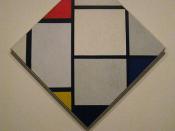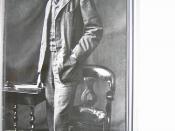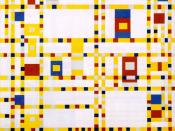"Broadway Boogie Woogie" by Piet Mondrian is the culminating achievement of his New York Period. Broadway Boogie Woogie was one of many pieces of Mondrian's that was exhibited at a retrospective of his life's work at the Museum of Modern Art in New York City. The exhibit traced the evolution of Mondrian's artistic career and its many changes.
The exhibit, "Piet Mondrian: 1872-1944" was the first major show to to study his career leading up to and through is discovery of abstract. There were near 170 paintings and drawings in the show from his early naturalistic paintings to his abstract neo-plasticism New York period (Kimmerlman B1). The exhibit did not only show Mondrian's work but how he worked; included in the show were his sketches, many works in progress, and a recreation of his final studio in New York City.
Piet Mondrian was born in Amersfoort , Holland in 1872 and started to study art a very early age.
At the age of fourteen he moved to Amsterdam to study painting. His early work was based in nineteenth-century Dutch realism. Mondrian's work transformed into the abstract slowly with the use of pure bright color after seeing the modernism work of Seurat, Matisse, and van Gogh in 1908 at a exhibition in Amsterdam. Mondrian explored modernism while living in Domberg, an avant-garde art colony along the coast in southwestern Holland. At the same time he became interested in the religious philosophy of theosophy, a blend of Eastern and Western religions which centers around the movement of humanity towards a spiritual unity. Theosophy also held that geometric shapes represented different stages in spiritual development which greatly interested Mondrian and influenced his work (Kermit 14).
Another major influence on Mondrian was works of Cézanne and the early cubism of...


